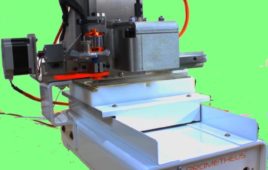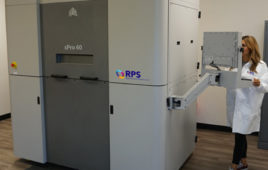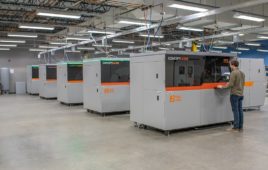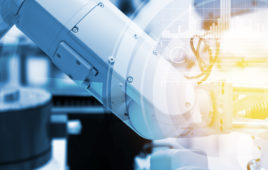Yet another product has been launched successfully, via the crowdsourcing start-up site, Kickstarter. Only this product reached its goal of $100,000 in less than three hours, and it stands to usher in the next revolution of 3D printing. The Form 1 printer from Form Labs has raised over $2.3M for its initial production, and the start-up company only has their eyes forward.
Next Steps in 3D Printing
Form Labs has essentially taken the next step in 3D printing. The Form 1 is a desktop stererolithography printer that operates from a simplified proprietary software program by Form Labs. This method is the oldest process of 3D printing. Max Lobovsky of Form Labs explains further, “Stereolithography is generally known for some of the highest resolutions and accuracies in the 3D printing process.” Usually, the process is done on very high-end machines that run into the $100,000 price range.
The Form 1 aims to remedy that price-point by offering a desktop printer that is capable of the same high-definition as its big brothers for less than $5,000. Though the desktop 3D printer realm has been relegated to FDM printers, the Form 1 utilizes a blu-ray type laser to reduce cost and size, allowing stereolithography to take over the desktop.
Using a software platform that is accepting of STL format files (typical of most CAD programs), this stereolithography process draws a laser beam across the surface of a liquid resin that hardens when it is exposed to a specific wavelength of light.
Once a layer is drawn, the build platform lifts so the laser can harden another layer. The process continues until the part is finished. “The speed is comparable to other high-res machines, but resolution is hard to define. As far as layer resolution we go down to 25 microns, which is about four times smaller than any of the FDM machines on the market claim,” says Lobovsky. “What we call the minimum feature size is more important. The smallest wall thickness or finest point goes down to .3 mm or 300 microns, and that is where I think we dramatically outshine the FDM printers.”
It’s a Changing World
Lobovsky makes a powerful analogy between the current 3D printer market and the PC market in the 70s. “The mainframes of old are the professional 3D printers today. PCs were just coming on the market, like FDM printers, and they weren’t exactly sure what people were going to do with them,” he says. As PCs became more widely available and user-friendly software was developed, new applications were quickly discovered. “We might be able to see that same kind of disruptive technology effect with 3D printers.”
Until access to blu-ray was available, no suitable, low-cost lasers could be used for a desktop-style printer, but the design process included more than simply finding the right laser system. Lobovsky explains, “A lot of what we did was rethink the entire 3D printing system. [We] looked at it not from a ‘here’s the requirements perspective,’ instead we started from a perspective that this thing needs to be affordable and easy enough to use to be on every designer’s desktop.”
Form 1 had no trouble finding a niche in the market, as demonstrated by their overwhelming Kickstarter response. “There aren’t many products between $2,000 and $10,000, and that also reflects a hole in what the marketplace of products can do,” says Lobovsky. He explains that there really aren’t any affordable, middle-grade printers available right now. “The $10,000 printers are professional machines that are used for work by major organizations, and the low-end printers are hobbyist machines or a toys to some degree.” The hole in the market lies in providing high-quality 3D prototypes for smaller, independent companies who have to contract prototypes from larger companies because printing them on their own is too pricey.
Dawn of a New Era
So, what is the key to the Form 1’s success? “People have been waiting for a tool like this. Similar to the PC market of old, these hobbyist 3D printing machines have kind of primed the market to expect this tool to exist,” says Lobovsky. The overwhelming response to their Kickstarter campaign is certainly just the beginning as “all of these customers seemed to know this was coming; they were waiting for it.”
As the design world becomes more accessible to everybody through tools like this, one question looms: How does this new evolution benefit professional engineers? Though contract prototyping services, as well as desktop hobby printers, will always have a place in the market, this new era brings much-needed access to smaller and independent engineering firms. Lobovsky explains, “Getting more immediate access to these tools can change how designers and engineers work.” Traditional prototyping methods, including other methods of 3D printing, aren’t timely and bear a cost, so designers shy away from trying the full array of designs that they have to keep the process economical. This forces designers to treat the prototyping process as a fixed stage in the design progression. “[This method of 3D printing] facilitates a continual loop of trying things, and then going back, redesigning, and trying again,” says Lobovsky. “This product is obviously meant for OEM, small budget type of engineers. Making more work possible by smaller, independent entities.”
In the world of design and engineering there is little room to stand still, so progress and adaptation are integral to products and processes alike. Building on predecessors was essential to the design process of the Form 1 printer. “I don’t think the Form 1 would have been possible to develop without other tools like it. We had one of those low-cost 3D printers in our office, and we used a range of new tools and services, like MFG.com and First Cut, to get manufacturing ramped up easier.” says Lobovsky. Services like MFG.com match suppliers with designers via a request form and either CAD or technical specs. This gives designers the opportunity to find more appropriate and convenient suppliers for their products as they head to the manufacturing stage. Services like First Cut offer contract machining for prototyping purposes in the materials being used. As the torch is passed, these services will still have value, but systems like Form 1, have already made their importance in the marketplace known.
Pre-Order Madness
One of the difficulties with Kickstarter is the delivery of a promised product. Starting a product line as an idea with potential and ending with over $2M in orders can be an intimidating situation. Lobovsky digresses on Form Labs’ situation, “Right now we are certainly worried about keeping up with demand. That’s why we originally set up different tiers on Kickstarter where we promised different ship dates, so we’re trying to stage the demand.” This may be a good problem to have, but Kickstarter has seen other organizations fall flat with these issues. Form Labs has their priorities set, and they are “pushing to hit those goals.”
Since the Form 1 3D printer hit its goal within a few short hours of the campaign start, delivery will begin in January 2013. Though they are currently relishing in their success, Form Labs is already hard at work creating a new project and developing the next big thing. The Form 1 fills a definitively recognized hole in the rapid prototyping world, and gives access to a high-res 3D printer at a reasonable price-point. Lobovsky says, “Some may be interested in this for fun and some may be for professional reasons, and there really is that kind of continuum there; the idea of prosumer (professional consumer) is about just that.”
Without a doubt, we are in the infancy of the 3D printing revolution. The level of progress, if we digress back to the PC analogy, is still pre-DOS. “There’s still a long way to go in just making these things easier to use, more affordable, and more capable; expanding the range of possibilities. There’s a lot to do. All I can say is that it’s exciting, and stay tuned.”
We have a long way to go before we hit the iPad of 3D printers, but progress is being made – quickly.
Filed Under: Rapid prototyping




